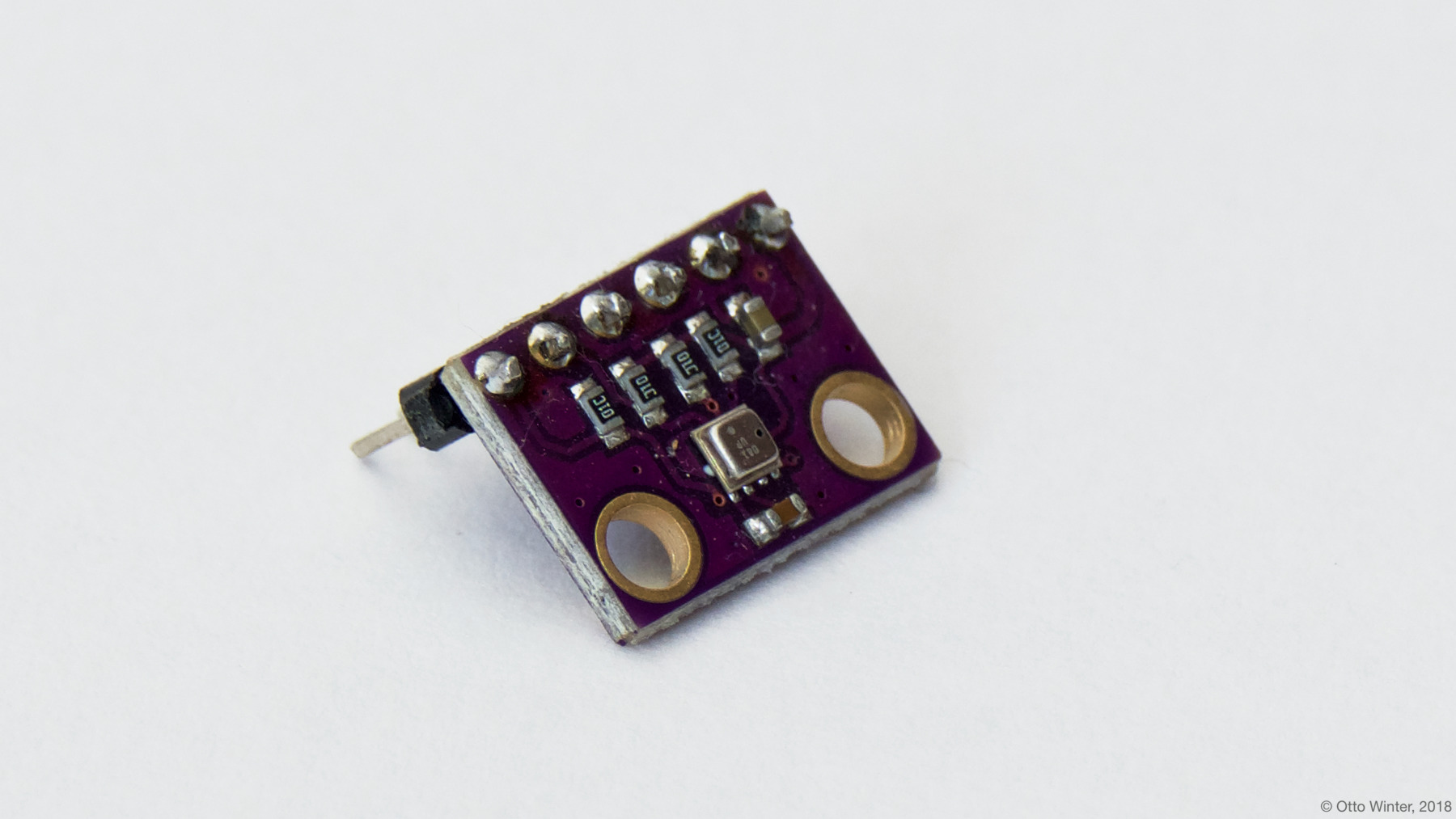BME280 Environment
The BME280 Temperature+Pressure+Humidity Sensor is a simple temperature, humidity, and pressure sensor with communication over I²C or SPI. With some simple math it is possible to either determine the height of the sensor, or the current pressure at sea level. This guide can be applied to any sensor measuring temperature and pressure at the same time, like the BMP280 Temperature+Pressure Sensor, or BME680 Temperature+Pressure+Humidity+Gas Sensor.

The first step is to connect the sensor as described here.
After validating the sensor is working, we can proceed and add some formulas.
In the example below, modify platform: bme280 as appropriate for your hardware (either bme280_i2c or bme280_spi).
See BME280 Temperature+Pressure+Humidity Sensor for specific details.
sensor:
- platform: bme280_i2c
temperature:
name: "BME280 Temperature"
id: bme280_temperature
pressure:
name: "BME280 Pressure"
id: bme280_pressure
humidity:
name: "BME280 Relative Humidity"
id: bme280_humidity
address: 0x77
update_interval: 15s
- platform: template
name: "Altitude"
lambda: |-
const float STANDARD_SEA_LEVEL_PRESSURE = 1013.25; //in hPa, see note
return ((id(bme280_temperature).state + 273.15) / 0.0065) *
(powf((STANDARD_SEA_LEVEL_PRESSURE / id(bme280_pressure).state), 0.190234) - 1); // in meter
update_interval: 15s
icon: 'mdi:signal'
unit_of_measurement: 'm'
- platform: absolute_humidity
name: "Absolute Humidity"
temperature: bme280_temperature
humidity: bme280_humidity
- platform: template
name: "Dew Point"
lambda: |-
return (243.5*(log(id(bme280_humidity).state/100)+((17.67*id(bme280_temperature).state)/
(243.5+id(bme280_temperature).state)))/(17.67-log(id(bme280_humidity).state/100)-
((17.67*id(bme280_temperature).state)/(243.5+id(bme280_temperature).state))));
unit_of_measurement: °C
icon: 'mdi:thermometer-alert'Altitude and absolute humidity
The first block sensor starts with the normal bme280 sensor components temperature, pressure,
and humidity with each their own id.
After the bme280 sensor, a Template Sensor is defined to calculate the altitude in a lambda.
The variable STANDARD_SEA_LEVEL_PRESSURE (in hPa), should be filled in for your location.
The formula derived from finitespace/BME280
on GitHub,
converts the currently measured pressure to the altitudes in meters including temperature compensation.
The second block uses the Absolute Humidity component which converts the currently measured temperature and relative humidity to absolute humidity (grams/m^3).
ℹ️ Note
Calculating the altitude with the BME280 sensor accurately requires this value to be known at sea level for your location and day.
This can be achieved by replacing the global constant
STANDARD_SEA_LEVEL_PRESSUREby for example pulling this value live from the internet or a stationary sensor via MQTT.
Equivalent sea level pressure
Calculating the sea level pressure with a statically mounted sensor can be used as reference for moving sensors as mentioned in the note above.
sensor:
- platform: bme280
temperature:
name: "BME280 Temperature"
id: bme280_temperature
pressure:
name: "BME280 Pressure"
id: bme280_pressure
humidity:
name: "BME280 Relative Humidity"
id: bme280_humidity
address: 0x77
update_interval: 15s
- platform: template
name: "Equivalent sea level pressure"
lambda: |-
const float STANDARD_ALTITUDE = 0.6; // in meters, see note
return id(bme280_pressure).state / powf(1 - ((0.0065 * STANDARD_ALTITUDE) /
(id(bme280_temperature).state + (0.0065 * STANDARD_ALTITUDE) + 273.15)), 5.257); // in hPa
update_interval: 15s
unit_of_measurement: 'hPa'ℹ️ Note
For calculating the equivalent sea level pressure, the sensor needs to be mounted at a fixed altitude. Therefore it is not possible to calculate altitude at the same time, and vice versa!

